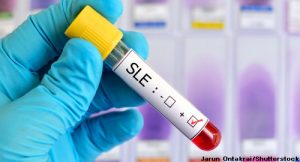 Better Understanding, Better Treatment
Better Understanding, Better Treatment
EULAR 2024 (VIENNA)—The exact etiopathogenesis of systemic lupus erythematosus (SLE) remains unclear, but we know that genetic risk, environmental exposures and immune dysregulation all play a role.1,2 In summer 2024, two studies furthered our understanding of the pathogenesis of this enigmatic disease. And if we can understand the pathogenesis of a disease, we can better diagnosis, treat and prevent it.
Genetics & Air Pollution: The Perfect Storm
“How did I get this, doc?” As rheumatologists, we all have different ways of responding to this question, and we all must answer it.
Personally, I start with relieving the patient of guilt. “First and foremost, I would like you to understand that this isn’t your fault. This [condition] is not because of something that you did,” I say.
Next, I use the perfect storm analogy. “There’s something in your genes that made you more likely to get this [condition] one day than somebody else.” And then, “there’s some kind of trigger. Something that wakes the immune system up and hits the gas, but somewhere along the line, forgets to hit the brakes.”

Dr. Xing
In June 2024, Xing et al. published a prospective cohort study online in Arthritis & Rheumatology that demonstrated an association between genetic susceptibility, air pollution and the risk of developing SLE.3 This finding makes sense because prior studies have shown that air pollution may influence SLE by “inducing oxidative stress, immune disorders and epigenetic changes, which can affect autoimmunity and inflammation response.”3,4 Other studies have demonstrated that short-term exposure to air pollutants is associated with an increased risk for SLE onset, disease activity and hospitalization.5 But only two Taiwanese studies have demonstrated an association between long-term exposure to air pollutants and the risk of incident SLE.6,7 Xing et al. provided long-term prospective data demonstrating this same association in Europe, where air pollution is significantly lower than in Taiwan.3
Xing et al. studied nearly half a million participants in the U.K. Biobank, a prospective cohort study with open accessibility, and the concentrations of different air pollutants to explore linkages between air pollutants and incident SLE. The majority of participants were white females in their 50s and 60s. The median follow up was 11.77 years.
The study found positive associations between air pollutant exposure and incident SLE, with adjusted hazard ratios ranging from 1.13 to 1.27 depending on the specific type of pollutant measured. Participants who had incident SLE were more likely to be female, non-White, former/current smokers and retired/unemployed with lower household incomes and increased air pollutant exposure than participants without SLE.
The researchers also used the polygenic risk score to assess the combined effect of genetic risk and air pollutants. We know SLE has a genetic background, given a concordance rate of 30–50% in monozygotic twins and substantial familial aggregation among patients with SLE.8,9 Genome-wide association studies (GWAS) have demonstrated over 60 risk loci for SLE vulnerability.8 The polygenic risk score assesses the cumulative effects of these multiple genetic risk variants. The higher the polygenic risk score, the higher the genetic risk of developing SLE one day.
Xing et al. found that participants with high genetic risk and high air pollution exposure had the highest risk of incident SLE, with adjusted hazard ratios ranging from 4.16 to 5.61. Simply put, high genetic risk and high air pollution exposure were found to be a double whammy.
Interview with the Investigators

Dr. Tian
Jian Yang, PhD, Department of Cardiology, The First College of Clinical Medical Science, China Three Gorges University & Yichang Central People’s Hospital, Yichang, China, and Yaohua Tian, PhD, Huazhong University of Science and Technology, Wuhan, China, offered insight on their fascinating research.
The Rheumatologist (TR): What should practicing rheumatologists take away from your findings?
Drs. Yang & Tian: Rheumatologists should be aware of the potential impacts of environmental factors, such as air pollution, on the development of SLE. This knowledge can help in understanding the multi-factorial nature of the disease and guiding patient assessments.
During patient evaluations, rheumatologists should inquire about environmental exposures, including air quality and potential pollutants. This approach could involve questions about where patients live and their occupational exposure and lifestyle factors—thus, guiding rheumatologists in preventive strategies for individuals with known risk factors.
Further, rheumatologists can contribute to the broader understanding of how such environmental factors may influence disease incidence and progression.
TR: Patients can’t change their genes (yet), and they may not be able to change where they live. With these factors in mind, what should patients do with this information?
Drs. Yang & Tian: Our current study provided novel evidence that air pollution not only contributes to cardiovascular and respiratory diseases, but also autoimmune diseases. Our current study could be used for health education and to remind people to pay attention to the adverse effects of air pollution on incident SLE, especially for people with genetic susceptibility. People may wear masks or reduce outings during poor air quality days.
TR: What should public health administrators do with this information?
Drs. Yang & Tian: Public health administrators should collect data on health outcomes related to air pollution to identify vulnerable populations and high-risk areas, advocate for stricter air quality regulations, support policies that promote clean energy and allocate resources for community health initiatives focused on education and prevention related to air quality issues.
TR: What can’t this study tell us?
Drs. Yang & Tian: Our current study was an observational study. Given that a meaningful correlation analysis result does not imply a causal association, we can’t confirm the causal link between air pollution and incident SLE. Further studies underlying biological mechanisms linking air pollution exposure to SLE pathogenesis need to be explored.
TR: What would be your next steps in terms of future research?
Drs. Yang & Tian: We plan to conduct similar studies in different populations and areas, such as China. Because China has a relatively high prevalence of SLE and severe air pollution, exploring this association could further strengthen our current evidence from the U.K. Biobank and guide the development of more stringent air quality standards.
SLE: Driven by T Cell Imbalance
In July 2024, groundbreaking new research from labs at Northwestern and the Brigham and Woman’s Hospital was published in Nature.10 This work has also led us closer to understanding the pathogenesis of SLE. B cells and autoantibodies are likely what come to mind for most of us when we think about SLE, but this research points to certain B cell-helping helper T cells as one of the main drivers of the disease. If we can address a main driver of SLE, we may be able to better treat it.
Because basic science may feel far away for many (me included), let me break a few things down before moving on to the interview with the corresponding authors.
SLE is driven by inappropriate interactions between B cells and T cells. Certain types of helper T cells—T follicular helper (TFH) cells and T peripheral helper (TPH) cells—are expanded in patients with SLE. TFH cells help B cells within lymphoid follicles, and TPH help B cells within inflamed peripheral tissues. The investigators explain that “both activated B cells and T cells that help B cells [as above] are inappropriately expanded in people with SLE and correlate with disease activity.”10
The investigators demonstrated that the aryl hydrocarbon receptor (AHR) helps regulate the balance of TFH and TPH cells, and patients with SLE have an imbalance of chemicals (e.g., type I interferon) that suppress the aryl hydrocarbon pathway. When the AHR is suppressed, pathogenic TFH and TPH cells expand. Thus, if suppressing AHR leads to the T cell imbalance characteristic of SLE patients and other autoimmune diseases, perhaps stimulating it may correct the imbalance and reprogram the T cells to better treat SLE.

Dr. Choi
Interview with the Investigators
It was truly a pleasure to speak with the corresponding authors of this article to better understand the value their findings bring to the field. Jaehyuk Choi, MD, PhD, Jack W. Graffin Professor, The Feinberg School of Medicine, Northwestern University, Chicago, Illinois, and Deepak A. Rao, MD, PhD, assistant professor of medicine, Division of Rheumatology, Inflammation, and Immunity, Brigham and Women’s Hospital and Harvard Medical School, Boston, Massachusetts, were kind enough to simplify their incredible research.
TR: Can you summarize your findings in simple language for our readers?
Dr. Rao: Lupus is driven by a pathologic T cell-B cell response that produces autoantibodies that mediate injury in multiple tissues. We have been searching for methods to disrupt the function of the T cells that drive B cell activation and antibody production in SLE—in particular TPH and TFH cells. We discovered that one specific transcription factor, AHR, can strongly inhibit T cell differentiation into TPH and TFH cells. Further, we found that type I interferon, a cytokine known to be produced excessively in lupus, promotes TPH and TFH cell generation in part through suppressing the actions and downstream effects of AHR.
Dr. Choi: We think there are chemical and cytokine imbalances in the blood of patients with SLE, including excess amounts of type I interferon and low levels of AHR activity. This chemical imbalance leads to the upregulation of pathogenic B helper-T cells (TPH and TFH cells).
TR: Why should practicing rheumatologists and patients living with lupus be excited about these findings?

Dr. Rao
Dr. Rao: This study reveals a new potential therapeutic strategy to treat SLE. We aim to use small molecule activators of AHR, directed specifically towards T cells, as a treatment to suppress the pathologic T cell response in lupus and to reprogram those T cells towards benign or even protective functions.
TR: What are the next steps in terms of future research? Are there currently studies underway for drugs that stimulate AHR?
Dr. Rao: The work so far is performed largely in vitro using T cells from patients with SLE or healthy controls. We do not yet know what will happen when a strategy like this is tried in patients. We are currently working to design strategies to selectively activate AHR in T cells without broader effects on other cells or tissues. We are also evaluating to what extent this imbalance in T cell responses is seen in other autoantibody-associated autoimmune diseases.
Dr. Choi: We are actively working on trying to utilize these technologies to develop novel drugs. It is a key priority for our labs.
TR: Might drugs that stimulate AHR have implications for other autoimmune diseases besides lupus?
Dr. Rao: Expansion of TPH cells and activated B cells occurs in many autoantibody-associated autoimmune diseases, including rheumatoid arthritis, Sjögren’s disease and others. It seems likely that strategies that inhibit the T cell-B cell response, including through the activation of AHR, could be beneficial across several of these diseases.
Conclusion
SLE is complicated for patients and providers alike. Studies like these pave the way for a better understanding, and a better understanding paves the way for better treatment. It’s an exciting time to be a rheumatologist.
Samantha C. Shapiro, MD, is a clinician educator who is passionate about the care and education of rheumatology patients. She writes for both medical and lay audiences and practices telerheumatology.
References
- Gulati G, Brunner HI. Environmental triggers in systemic lupus erythematosus. Semin Arthritis Rheum. 2018 Apr;47(5):710–717.
- Accapezzato D, Caccavale R, Paroli MP, et al. Advances in the pathogenesis and treatment of systemic lupus erythematosus. Int J Mol Sci. 2023 Mar 31;24(7):6578.
- Xing M, Ma Y, Cui F, et al. Air pollution, genetic susceptibility, and risk of incident systemic lupus erythematosus: A prospective cohort study. Arthritis Rheumatol. 2024 Jul 10. Online ahead of print.
- Glencross DA, Ho TR, Camiña N, et al. Air pollution and its effects on the immune system. Free Radic Biol Med. 2020 May 1;151:56–68.
- Rezayat AA, Niloufar jafari, Mir Nourbakhsh SH, et al. The effect of air pollution on systemic lupus erythematosus: A systematic review and meta-analysis. Lupus. 2022 Nov;31(13):1606–1618.
- Mai CH, Shih YJ, Lin CL, et al. Associations between fine particulate matter (PM2.5) and childhood-onset systemic lupus erythematosus. Indian J Pediatr. 2022 Feb;89(2):200.
- Jung CR, Chung WT, Chen WT, et al. Long-term exposure to traffic-related air pollution and systemic lupus erythematosus in Taiwan: A cohort study. Science of the Total Environment. 2019 Jun 10;668:342–349.
- Alarcón-Segovia D, Alarcón-Riquelme ME, Cardiel MH, et al. Familial aggregation of systemic lupus erythematosus, rheumatoid arthritis and other autoimmune diseases in 1,177 lupus patients from the GLADEL cohort. Arthritis Rheum. 2005 Apr;52(4):1138–1147.
- Jeong DY, Lee SW, Park YH, et al. Genetic variation and systemic lupus erythematosus: A field synopsis and systematic meta-analysis. Autoimmun Rev. 2018 Jun;17(6):553–566.
- Law C, Wacleche VS, Cao Y, et al. Interferon subverts an AHR-JUN axis to promote CXCL13+ T cells in lupus. Nature. 2024 Jul;631(8022):857–866.

